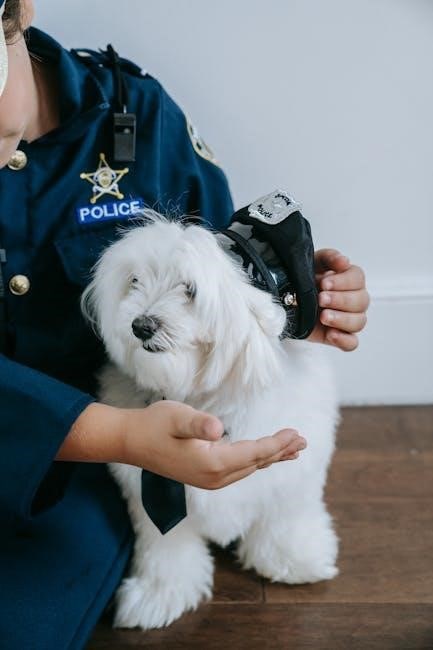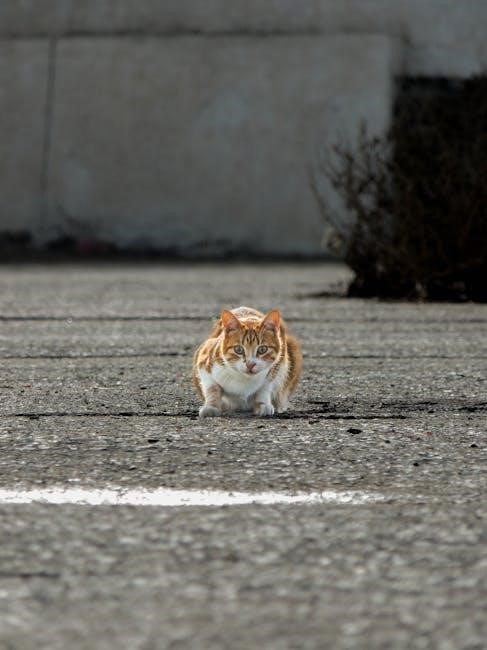brownie pet badge requirements pdf
Brownie Pet Badge Requirements Overview
The Brownie Pets Badge is designed to teach girls about responsible pet ownership. To earn this badge, Brownies must demonstrate knowledge of pet care and commitment to animal well-being. This involves learning about different pet needs, ensuring pet comfort, health, safety, and showing love to pets. The girls need to understand how to feed a pet.

Badge Requirements Summary
To secure the Brownie Pets Badge, girls must complete five key categories. These encompass understanding pet needs, ensuring comfort, and maintaining health and safety. Additionally, showing love and care, and proper feeding practices are essential. By fulfilling these requirements, Brownies demonstrate their dedication to responsible pet care and earn their badge.
Complete Five Categories
To successfully earn the Brownie Pets Badge, Girl Scouts are required to complete activities in five distinct categories. These categories are carefully designed to provide a comprehensive understanding of responsible pet ownership. Each category focuses on a different aspect of pet care, ensuring that the Brownies gain a well-rounded perspective.
The first category, “Pet Needs,” involves learning about the basic requirements of different types of pets, such as food, water, shelter, and exercise. The second category, “Pet Comfort,” focuses on creating a comfortable and safe environment for pets, including providing appropriate bedding and toys.
The third category, “Pet Health & Safety,” emphasizes the importance of keeping pets healthy and safe, including regular veterinary check-ups, vaccinations, and preventing accidents. The fourth category, “Pet Love,” encourages Brownies to show affection and provide companionship to their pets, fostering a strong bond between them.
Finally, the fifth category, “Feeding a Pet,” teaches Brownies about proper nutrition for different types of pets and the importance of providing a balanced diet. By completing activities in each of these five categories, Brownies will demonstrate their knowledge and commitment to responsible pet care, thus earning their Pets Badge.
Pet Needs
Understanding pet needs is essential for responsible pet ownership. This category focuses on educating Brownies about the diverse requirements of different animals. They learn about essential needs such as food, water, shelter, exercise, and veterinary care, ensuring pets live healthy lives.
Understanding Different Pet Needs
To properly care for a pet, it’s crucial to understand its specific needs. Animals, like people, have unique requirements that must be met to ensure their health and happiness. Brownies should learn that a dog’s needs differ significantly from a cat’s, a fish’s, or a bird’s. Researching and understanding these differences is the first step in responsible pet ownership.
For example, dogs need regular walks and playtime to stay active, while cats require scratching posts and opportunities to exhibit their natural hunting behaviors. Fish need clean tanks and specific water temperatures, while birds need spacious cages and mental stimulation through toys. By recognizing these varying needs, Brownies can make informed decisions about choosing the right pet for their lifestyle or providing the best possible care for a pet they already have.
Understanding these needs also involves recognizing signs of discomfort or illness in a pet. By being attentive and informed, Brownies can contribute to the well-being of their furry, scaled, or feathered friends. This knowledge promotes empathy and responsible pet care habits.
Pet Comfort
Creating a comfortable environment for a pet is essential for their well-being. This involves providing a safe, clean, and relaxing space where they can rest and feel secure. Comfort can be achieved through appropriate bedding, temperature control, and minimizing stressors in their surroundings.
Creating a Comfortable Space
Providing a comfortable space for a pet involves several key elements that cater to their specific needs. First, ensure the pet has a designated resting area, such as a cozy bed or crate, lined with soft bedding. This space should be clean and free from drafts, offering a sense of security and warmth.
Temperature control is also crucial; pets should be protected from extreme heat and cold. In hot weather, provide shade, ventilation, or cooling mats. In cold weather, offer warm blankets and keep them indoors. Minimize stressors by keeping the area quiet and away from loud noises or high-traffic zones.
Regularly clean the pet’s space to maintain hygiene and prevent odors. For animals like cats, ensure litter boxes are easily accessible and cleaned frequently. Additionally, consider the pet’s natural behaviors. Cats may appreciate elevated perches, while dogs may enjoy having a view of the outside world.
Finally, positive reinforcement can help a pet associate their space with comfort and security. Reward them with treats or praise when they use their designated area, creating a positive and relaxing environment.

Pet Health & Safety
Maintaining pet health and safety involves proactive measures. This includes regular veterinary check-ups, vaccinations, and parasite prevention. A safe environment free from hazards is essential. Proper grooming and awareness of potential toxins also contribute to their well-being, leading to a healthier, happier pet.
Keeping Pets Healthy and Safe
Ensuring the health and safety of pets is paramount for responsible pet ownership. This involves several key areas, starting with preventative care. Regular vaccinations are crucial for protecting pets from common and potentially deadly diseases; Parasite prevention, including flea, tick, and heartworm control, is also essential for maintaining their well-being.
Creating a safe environment is another critical aspect. This means identifying and removing potential hazards from the pet’s surroundings. Toxic substances, such as certain household cleaners and medications, should be stored out of reach. Sharp objects and electrical cords should be secured to prevent injuries.
Proper grooming plays a vital role in maintaining a pet’s health. Regular brushing helps to remove loose fur, preventing mats and skin problems. Nail trimming is necessary to avoid discomfort and potential injuries. Dental care, including teeth brushing and professional cleanings, is important for preventing dental disease.
Being aware of potential health issues and seeking prompt veterinary care is also crucial. Owners should monitor their pets for any signs of illness, such as changes in appetite, behavior, or energy levels. Consulting a veterinarian at the first sign of trouble can help ensure early diagnosis and treatment.
Visiting a Veterinarian
A visit to the veterinarian is a crucial part of keeping pets healthy. Veterinarians play a vital role in preventative care, diagnosing illnesses, and providing treatment. Regular check-ups are essential for monitoring a pet’s overall health and detecting potential problems early on. These visits typically include a physical examination, vaccinations, and parasite prevention.
During a veterinary visit, owners have the opportunity to ask questions and address any concerns they may have about their pet’s health. It’s important to be prepared with a list of questions and to provide the veterinarian with a complete medical history of the pet. This includes information about any past illnesses, medications, and dietary habits.
Veterinarians also provide guidance on proper nutrition and exercise. They can recommend appropriate food choices and help owners develop a suitable exercise plan for their pet’s specific needs. Additionally, veterinarians offer advice on behavioral issues and can recommend training techniques or refer owners to qualified trainers.
In case of illness or injury, a veterinarian is the primary source of medical care for pets. They can diagnose the problem, prescribe medications, and perform necessary procedures. It’s essential to seek veterinary care promptly if a pet exhibits any signs of illness or distress.

Pet Love
Showing love to a pet involves spending quality time with them and making them feel safe and valued. Playing games, offering gentle affection, and providing a comforting presence contribute to a pet’s emotional well-being. Positive interactions strengthen the bond between a pet and their owner.
Making a Pet Feel Loved
Making a pet feel loved is a crucial aspect of responsible pet ownership, as it contributes significantly to their overall happiness and well-being. Pets, like humans, thrive on affection and positive interactions. One of the simplest ways to show love is through physical touch. Gentle petting, scratching behind the ears, or cuddling can create a sense of security and comfort for your pet.
Spending quality time with your pet is another essential element of showing love. Engaging in activities they enjoy, such as playing fetch with a dog or providing interactive toys for a cat, strengthens the bond and provides mental stimulation. Regular walks, even short ones, can be a great way to bond with your dog while ensuring they get the exercise they need.
Verbal affirmation also plays a role in making a pet feel loved. Talking to your pet in a gentle and soothing voice can reassure them and make them feel secure. Praising them for good behavior and using their name affectionately reinforces positive associations and strengthens the connection between you and your pet. Creating a safe and comfortable environment also shows your pet that you care about their well-being.

Feeding a Pet
Proper nutrition is fundamental to a pet’s health and well-being. Understanding the specific dietary needs of different animals is crucial for responsible pet ownership. Cats, dogs, birds, and rodents all require different types of food in varying amounts to thrive. Providing a balanced diet ensures that pets receive the essential nutrients they need for energy, growth, and overall health.
When selecting pet food, it is important to consider the animal’s age, breed, activity level, and any specific health conditions. Puppies and kittens, for example, require food formulated to support their rapid growth, while senior pets may benefit from diets tailored to their changing needs. Consulting with a veterinarian can help determine the best food for your pet and the appropriate portion sizes.
Establishing a regular feeding schedule is also essential. Consistency in meal times helps regulate a pet’s metabolism and prevents overeating. Providing fresh, clean water at all times is equally important. Obesity is a common problem in pets, so it is crucial to monitor their weight and adjust their food intake accordingly. Avoiding table scraps and treats high in sugar and fat will help maintain a healthy weight.


